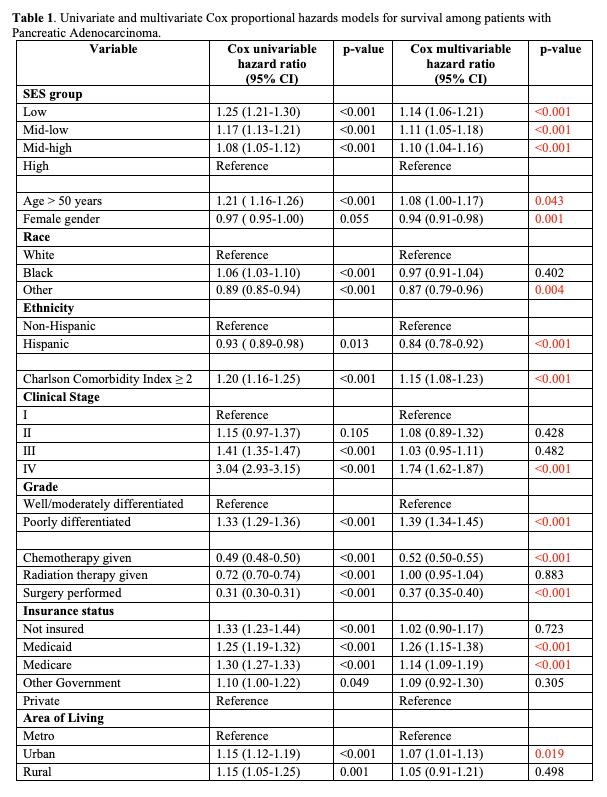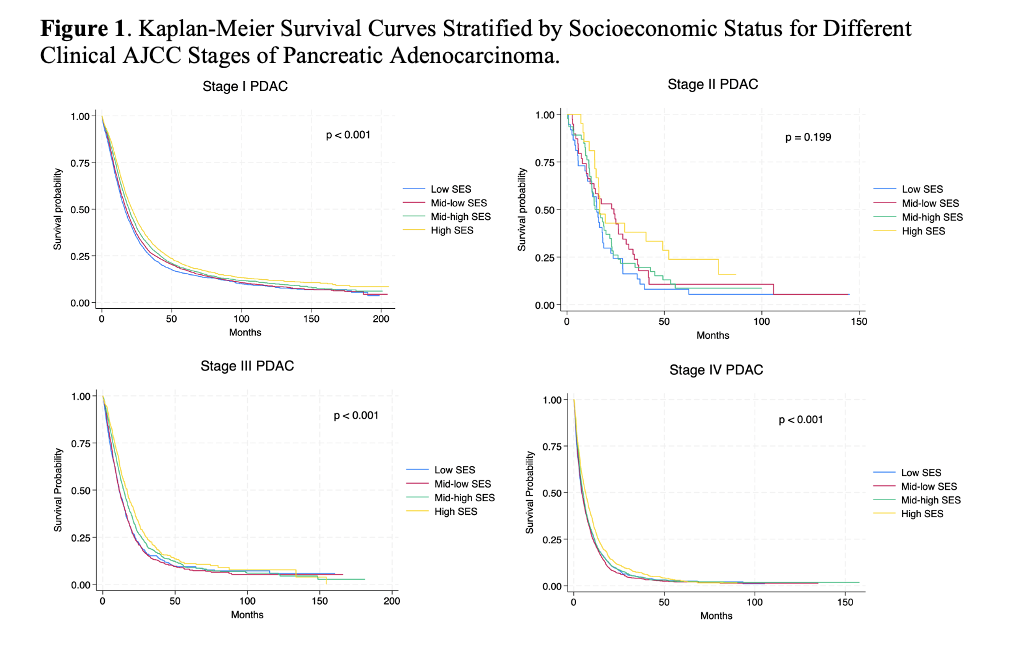Sunday Poster Session
Category: Biliary/Pancreas
P0038 - Socioeconomic Disparities in Survival Outcomes of Pancreatic Adenocarcinoma: Analysis of the National Cancer Database
Sunday, October 26, 2025
3:30 PM - 7:00 PM PDT
Location: Exhibit Hall
- SH
Sheraz Hakeem, MD
Aga Khan University
Karachi, Sindh, Pakistan
Presenting Author(s)
Sheraz Hakeem, MD1, Sheharyar Hakeem, MD2, Mohsin Chundrigar, MBBS3, Divya Patel, MD4
1Aga Khan University, Karachi, Sindh, Pakistan; 2The Brooklyn Hospital Center, Brooklyn, NY; 3Albany Medical Center, Albany, NY; 4Allegheny General Hospital, Pittsburgh, PA
Introduction: Pancreatic adenocarcinoma (PDAC) is an aggressive malignancy with a poor prognosis. Socioeconomic status (SES) is a critical but under-explored determinant of health disparities. This study investigated the interplay between SES and clinical outcomes across different AJCC stages of PDAC.
Methods: Our study population was identified by querying the National Cancer Database (NCDB) for patients diagnosed with PDAC during 2004-2019. The quartile rankings of individual income and education levels were combined as a composite measure of SES, which identified 4 groups: low (2-3), mid-low (4-5), mid-high (6-7), and high (8) SES. Cox proportional hazards models were employed to compare overall survival (OS) between SES groups across each clinical stage of PDAC, adjusting for relevant demographic and clinical variables.
Results: Of 45,409 PDAC patients, the distribution across SES groups was 18.17% for low SES (7,515 patients), 28.55% for mid-low SES (11,806 patients), 32.44% for mid-high SES (13,413 patients), and 20.84% for high SES (8,617 patients). Cox multivariate analysis revealed significantly decreased OS among patients in the low SES group (HR 1.14, 95% CI: 1.06-1.21), mid-low SES (HR 1.11, 95% CI: 1.05-1.18), and mid-high SES (HR 1.10, 95% CI: 1.04-1.16) when compared to the high SES reference group (Table 1). Kaplan-Meier survival analysis confirmed that differences in OS across SES group remained statistically different within AJCC stages I, III, and IV (Figure 1). Insurance status also influenced survival, with Medicaid patients showing a higher risk compared to those with private insurance (HR = 1.26; 95% CI: 1.15-1.38). Female sex (HR = 0.94; 95% CI: 0.91-0.98), Hispanic ethnicity (HR = 0.84; 95% CI: 0.78-0.92) and clinical stage (HR = 1.74; 95% CI: 1.62-1.87), administration of chemotherapy (HR = 0.52; 95% CI: 0.50-0.55), and surgical resection (HR = 0.37; 95% CI: 0.35-0.40) were also associated with better survival outcomes.
Discussion: This analysis underscores significant survival disparities among patients with PDAC across different SES groups, with lower SES being consistently associated with poorer outcomes. The association between SES and insurance status as independent indicators of survival underscores the importance of considering socioeconomic factors in the clinical management of PDAC and highlights the necessity for healthcare policy reforms.

Figure: Table 1. Univariate and multivariate Cox proportional hazards models for survival among patients with Pancreatic Adenocarcinoma

Figure: Figure 1. Kaplan-Meier Survival Curves Stratified by Socioeconomic Status for Different Clinical AJCC Stages of Pancreatic Adenocarcinoma
Disclosures:
Sheraz Hakeem indicated no relevant financial relationships.
Sheharyar Hakeem indicated no relevant financial relationships.
Mohsin Chundrigar indicated no relevant financial relationships.
Divya Patel indicated no relevant financial relationships.
Sheraz Hakeem, MD1, Sheharyar Hakeem, MD2, Mohsin Chundrigar, MBBS3, Divya Patel, MD4. P0038 - Socioeconomic Disparities in Survival Outcomes of Pancreatic Adenocarcinoma: Analysis of the National Cancer Database, ACG 2025 Annual Scientific Meeting Abstracts. Phoenix, AZ: American College of Gastroenterology.
1Aga Khan University, Karachi, Sindh, Pakistan; 2The Brooklyn Hospital Center, Brooklyn, NY; 3Albany Medical Center, Albany, NY; 4Allegheny General Hospital, Pittsburgh, PA
Introduction: Pancreatic adenocarcinoma (PDAC) is an aggressive malignancy with a poor prognosis. Socioeconomic status (SES) is a critical but under-explored determinant of health disparities. This study investigated the interplay between SES and clinical outcomes across different AJCC stages of PDAC.
Methods: Our study population was identified by querying the National Cancer Database (NCDB) for patients diagnosed with PDAC during 2004-2019. The quartile rankings of individual income and education levels were combined as a composite measure of SES, which identified 4 groups: low (2-3), mid-low (4-5), mid-high (6-7), and high (8) SES. Cox proportional hazards models were employed to compare overall survival (OS) between SES groups across each clinical stage of PDAC, adjusting for relevant demographic and clinical variables.
Results: Of 45,409 PDAC patients, the distribution across SES groups was 18.17% for low SES (7,515 patients), 28.55% for mid-low SES (11,806 patients), 32.44% for mid-high SES (13,413 patients), and 20.84% for high SES (8,617 patients). Cox multivariate analysis revealed significantly decreased OS among patients in the low SES group (HR 1.14, 95% CI: 1.06-1.21), mid-low SES (HR 1.11, 95% CI: 1.05-1.18), and mid-high SES (HR 1.10, 95% CI: 1.04-1.16) when compared to the high SES reference group (Table 1). Kaplan-Meier survival analysis confirmed that differences in OS across SES group remained statistically different within AJCC stages I, III, and IV (Figure 1). Insurance status also influenced survival, with Medicaid patients showing a higher risk compared to those with private insurance (HR = 1.26; 95% CI: 1.15-1.38). Female sex (HR = 0.94; 95% CI: 0.91-0.98), Hispanic ethnicity (HR = 0.84; 95% CI: 0.78-0.92) and clinical stage (HR = 1.74; 95% CI: 1.62-1.87), administration of chemotherapy (HR = 0.52; 95% CI: 0.50-0.55), and surgical resection (HR = 0.37; 95% CI: 0.35-0.40) were also associated with better survival outcomes.
Discussion: This analysis underscores significant survival disparities among patients with PDAC across different SES groups, with lower SES being consistently associated with poorer outcomes. The association between SES and insurance status as independent indicators of survival underscores the importance of considering socioeconomic factors in the clinical management of PDAC and highlights the necessity for healthcare policy reforms.

Figure: Table 1. Univariate and multivariate Cox proportional hazards models for survival among patients with Pancreatic Adenocarcinoma

Figure: Figure 1. Kaplan-Meier Survival Curves Stratified by Socioeconomic Status for Different Clinical AJCC Stages of Pancreatic Adenocarcinoma
Disclosures:
Sheraz Hakeem indicated no relevant financial relationships.
Sheharyar Hakeem indicated no relevant financial relationships.
Mohsin Chundrigar indicated no relevant financial relationships.
Divya Patel indicated no relevant financial relationships.
Sheraz Hakeem, MD1, Sheharyar Hakeem, MD2, Mohsin Chundrigar, MBBS3, Divya Patel, MD4. P0038 - Socioeconomic Disparities in Survival Outcomes of Pancreatic Adenocarcinoma: Analysis of the National Cancer Database, ACG 2025 Annual Scientific Meeting Abstracts. Phoenix, AZ: American College of Gastroenterology.
